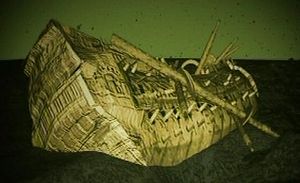HMS London (1656)
 The wreck of HMS London | |
| Career (England) | |
|---|---|
| Name: | HMS London |
| Ordered: | 3 July 1654 |
| Builder: | Taylor, Chatham |
| Launched: | June 1656 |
| Fate: | Accidentally blown up, 7 March 1665 |
| General characteristics [1] | |
| Class and type: | 64-gun Second rate ship of the line |
| Tons burthen: | 1,104 long tons (1,121.7 t) |
| Length: | 123 ft 4 in (37.6 m) (keel) |
| Beam: | 41 ft (12.5 m) (after girdling) |
| Depth of hold: | 16 ft 6 in (5.0 m) |
| Propulsion: | Sails |
| Sail plan: | Full rigged ship |
| Armament: | 64 guns of various weights of shot |
HMS London was a 64-gun Second rate ship of the line of the English Royal Navy, originally built for the navy of the Commonwealth of England at Chatham by Captain John Taylor, and launched in June 1656.[1] She gained fame as one of the ships that escorted Charles II from Holland back to England during the English Restoration, carrying Charles' younger brother James Duke of York, and commanded by Captain John Lawson.[2][3]
London was accidentally blown up in 1665 and sank in the Thames Estuary.[1] According to Samuel Pepys 300 of her crew were killed, 24 were blown clear and survived, including one woman.[4] Lawson was not aboard at the time of the explosion though many of his relatives were killed. The wreck was rediscovered in 2008, resulting in the port authorities changing the route of the shipping channel to prevent further damage and to allow archaeologists from Wessex Archaeology led by Frank Pope to investigate, leading to what was the largest ever post-war salvage operation on the Thames.
London recently featured in "Thames Shipwrecks: A Race Against Time," a BBC series on shipwrecks in the Thames.[5].
The two sites where the remains lie were designated under the Protection of Wrecks Act 1973 on 24 October 2008[6][7]. The wreck is considered important partly for its historical references and partly for its insight into an important period in British naval history. Although the Port of London authority had voluntarily taken action to reduce the risk of damage to shipping, the removal of bronze cannon from the site without any archaeological investigations being carried out showed that the site was at risk of destruction through looting and hence required immediate protection.[7][8]
Pepys Diary Entry
Samuel Pepys wrote about hearing of the loss of HMS London, on 8 March 1665, writing:
- "This morning is brought me to the office the sad newes of “The London,” in which Sir J(ohn) Lawson’s men were all bringing her from Chatham to the Hope, and thence he was to go to sea in her; but a little a’this side the buoy of the Nower, she suddenly blew up. About 24 [men] and a woman that were in the round-house and coach saved; the rest, being above 300, drowned: the ship breaking all in pieces, with 80 pieces of brass ordnance. She lies sunk, with her round- house above water. Sir J(ohn) Lawson hath a great loss in this of so many good chosen men, and many relations among them. I went to the ‘Change, where the news taken very much to heart." [9]
Notes
- ↑ 1.0 1.1 1.2 Lavery, Ships of the Line vol.1, p160.
- ↑ http://freespace.virgin.net/michael.overton1/the%20commission.htm
- ↑ http://www.pepysdiary.com/p/110.php#wheatley
- ↑ http://www.thisislondon.co.uk/news/article-23544808-details/Pictured:+Divers+discover+amazingly+preserved+shipwreck+of+HMS+London+on+bottom+of+Thames/article.do
- ↑ http://www.bbc.co.uk/programmes/b00d7j6b
- ↑ http://www.opsi.gov.uk/si/si2008/uksi_20082775_en_1
- ↑ 7.0 7.1 http://www.culture.gov.uk/reference_library/media_releases/5565.aspx
- ↑ http://www.divernet.com/cgi-bin/articles.pl?id=7721&sc=1&ac=d&an=7721:HMS+London+to+be+protected...
- ↑ http://www.pepysdiary.com/archive/1665/03/
References
- Lavery, Brian (2003) The Ship of the Line - Volume 1: The development of the battlefleet 1650-1850. Conway Maritime Press. ISBN 0-85177-252-8.
- Winfield, Rif (2009) British Warships in the Age of Sail 1603-1714: Design, Construction, Careers and Fates. Seaforth Publishing. ISBN 978-1-84832-040-6.
